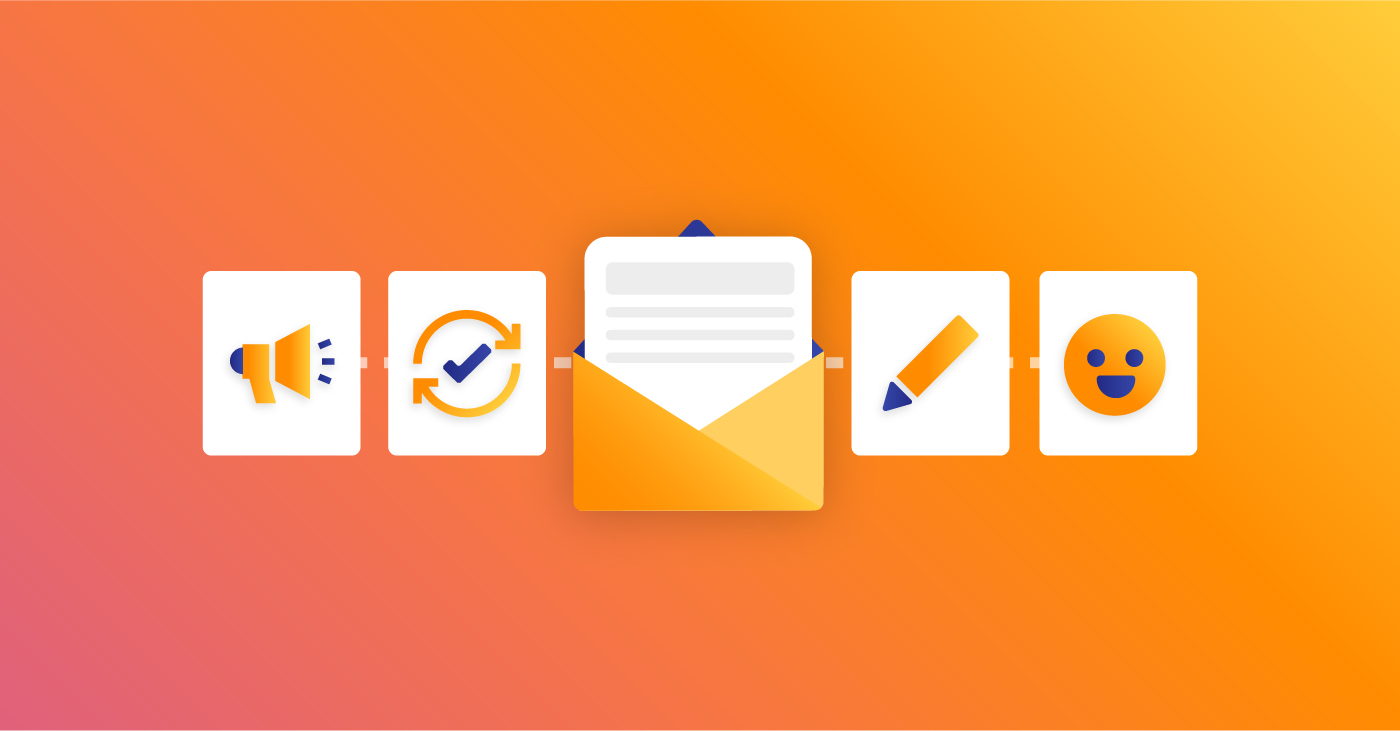Establishing a Brand Connection: Your Biggest 2023 Email Marketing Objective
November 30, 2022 7 min read

Getting your marketing strategy right is one of the most challenging aspects of running a business. With advances in technology, consumer behavior, and competition all constantly shifting, it’s never been more critical to stay on top of your game.
There’s no denying that email marketing is still an effective way to grow your business, but people want more than just regular emails in their inboxes. Many of today’s customers want real connections with businesses. According to customer engagement research, 84% of customers prioritize being treated like a person rather than just a number in your marketing email list.
In this piece, we’ll share six ways you can build authentic connections with your audience using email marketing.
Why is Establishing Customer-Brand Connection Important?
There are plenty of good reasons to focus on establishing a customer-brand connection as a business owner, and chief among them is the fact that it could lead to increased brand loyalty and customer retention. Your prospects and customers will see you as more than just a faceless corporation, instead viewing you as a relatable, human entity they can connect with personally.
And, as any good marketer knows, it’s easier and cheaper to keep existing customers than to acquire new ones. Additionally, when you have that connection with your audience, they can be the doors to new customers for you.
Establishing a solid customer-brand connection makes your customers more likely to engage with your brand, recommend your products or services to others, and give you valuable feedback that can help improve your business.
7 Ways To Build Customer-Brand Relationship With Email Marketing
Here are some ways to use email marketing to build customer-brand relationships.
1. Communicate Honestly
Honesty in your email marketing means being clear and transparent with your subscribers about what they can expect from your emails. It also means being honest about any promotions or deals you offer and not trying to trick people into clicking on your links or engaging with your content.
Honest communication will help break down any barriers between your brand and your consumers. It will show them that you have nothing to hide and that your intentions are simply to provide them with the resources they need. This will make their experience with your brand one they won’t forget and make them more inclined to recommend you to others they feel could benefit from what you have to offer.
Your subscribers should always know what they can expect from you, whether it’s special offers, new product announcements, or helpful tips and advice. Never use false pretenses to get people to open your email or subscribe – that will only lead to a quickly deleted message, being marked as spam, and losing subscribers.
2. Develop and Use a Brand Voice
Your brand voice is the personality of your business that comes through in your communications. When it comes to email marketing, your brand voice is just as important as the message you’re trying to communicate.
If you don’t have a brand voice yet, start by thinking about the overall tone of your communications. Are you casual or formal? Or do you sound witty or serious? Friendly and approachable? Humorous? Serious and professional? Once you have a general idea of the tone you want your email communications to strike, be consistent in using that voice.
In addition to being consistent, make sure your brand voice is authentic. Your readers can tell if you’re being genuine or not, so it’s crucial you pick a voice that works. Be yourself, and let your unique personality shine through in your emails.
With a consistent brand voice, building trust will be easier, and you’ll connect better with your readers, leaving a lasting impression.
3. High-Quality and Valuable Content
If you want to build a customer-brand relationship with your subscribers, you need to focus on creating interesting, informative, well-written content that is engaging and provides real value to your readers.
When creating your content, ask yourself, what can you provide that would be of value to your audience? What information can you share that would be helpful or interesting to them? How can you make your content engaging so people will want to read it?
When you consistently create high-quality email content that your subscribers get value from, they’ll appreciate it and show that appreciation through conversions.
4. Know Your Readers
Understanding your audience is regarded as the first step to email marketing success, and it’s also important in building a customer-brand relationship with your audience. You need to know who they are, what they do, and how often they want to hear from you.
You can use surveys to get demographic data, collect data about their preferences, and use the information to tailor your content to their needs. If you don’t know your audience, there is no way you can build a relationship with them.
Also, make your subscribers feel at ease with your communication by using a send-from address and name, and make it easy for them to unsubscribe from your list. This may seem counter-intuitive, but that way, you will only have a subscriber base of people who genuinely want to connect to you and your brand.
5. Offer a Thank You Gift for New Subscribers
83% of consumers will choose to be loyal to a business that offers them value-added rewards or surprises. When someone takes the time to sign up for your email list, they show you that they’re interested in your brand and what you have to say. They’re also permitting you to contact them directly. That’s a big deal!
Offering a thank-you gift to new subscribers gives you a valuable opportunity to connect with your audience. It could be something as simple as a coupon code for their next purchase, a free eBook, or a whitepaper related to your industry. Whatever gift you offer, make sure it’s something that will add value for your subscribers.
Not only will this help you connect with your audience, but it will also help you build goodwill with your new subscribers and encourage them to stick around and continue reading your upcoming communication.
6. Don’t Be Pushy
If you are all about email content that promotes a product or sells something, your email marketing will not be effective, and you’ll also lose that connection with your customers.
Content that provides value to your readers connects you with your audience and offers more sales opportunities than content that is salesy and always pushes your subscribers to make purchases.
Of course, you can still promote your products and services in your emails, but be sure to do it in a way that doesn’t feel like you’re constantly trying to sell them something. For example, instead of sending a promotional email multiple times a week, try sending one promotional email for every five to ten valuable emails you send.
Other Email Tips and Strategies to Establish a Connection
Beyond building a solid customer-brand relationship with your audience, there are some other email tips and strategies that can help you improve your email marketing. These include:
- Personalization: Add a personal touch to your emails to make them more effective. Try addressing recipients by name or including personalized content based on subscribers’ interests or past interactions with your brand.
- A/B Testing: Testing different versions of your emails and email elements can help you determine what works best with your audience and improve your open rates.
- List Maintenance: A clean email list is vital for effective email marketing. Make sure you regularly remove inactive subscribers and update the contact information of your contacts where applicable.
- Segmentation: By segmenting your email list, you can send targeted and relevant emails to your subscribers. This will help improve engagement and conversion rates.
- Subject line optimization: Your email subject line is the first thing recipients will see when they receive your emails, so make sure it’s attention-grabbing, doesn’t make false promises, and is relevant to the content in your email.
Web3 and What it Means for Brand-Consumer Connection
Web3 is all about bringing people and data together while putting data control and privacy in the hands of the people. Marketing in Web3 will focus more on personal communication, behavioral marketing, and the user.
As a result, emails will need to become even more personalized and interactive in order to resonate with consumers. The plus side is that business owners and marketers can track engagement in real-time and adjust their campaigns accordingly to make them as tailored as possible.
What does this mean for the brand-consumer connection? Well, the more in step you are with your audiences’ motivations and needs, the better you’re able to connect. You’ll know what they need when they need it and why. And that’s a great stepping stone for long-term, valuable relationships.
How can you harness Web3 for your business’s email marketing?
- Create a 2-way conversation with your customers via email. Ask them questions, solicit feedback, and start building relationships.
- Use data from your website and other channels to personalize your emails. Send relevant content that appeals to each individual’s interests.
- Take advantage of real-time engagement data to fine-tune your campaigns for the best results.
- Be transparent about how you collect and use customers’ data.
If you’re looking for one goal to focus on in 2023, we recommend making “building solid customer-brand relationships” your top priority. By focusing on this objective for your email marketing, you’ll be able to create more meaningful connections with your customers that will improve your retention rates, boost your revenue, and benefit your business long-term.



